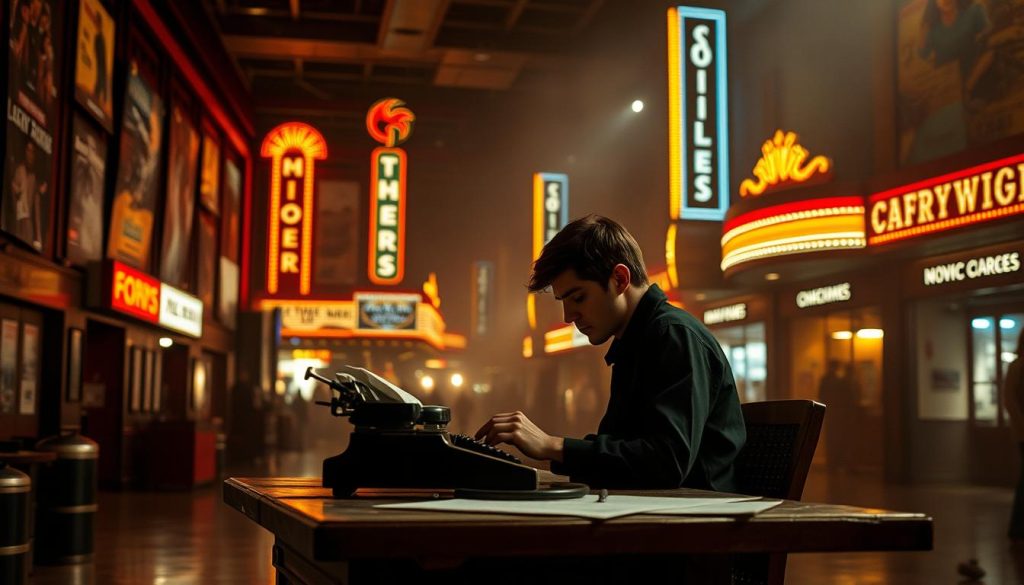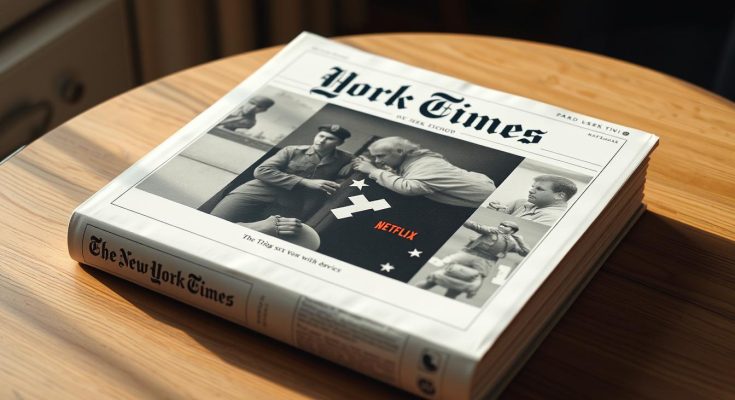Netflix’s latest war movie, “The Six Triple Eight“, has garnered significant attention with its release. Recently, it received a review from The New York Times, highlighting its historical significance and cinematic value.
The film, directed by Tyler Perry, sheds light on the untold story of the 6888th Central Postal Directory Battalion, an all-black unit during World War II. This article will delve into the New York Times’ review and explore the historical context and impact of the movie.
By examining the review and the film’s historical significance, we aim to provide a comprehensive understanding of “The Six Triple Eight” and its relevance in today’s cultural landscape.
The Untold Story Comes to Light
In a powerful tribute to the unsung heroes of World War II, Netflix presents ‘The Six Triple Eight,’ a film that sheds light on the remarkable achievements of the 6888th Central Postal Directory Battalion. This battalion, comprising African American women, played a crucial role in the war effort, overcoming numerous challenges and breaking barriers in military service.
Netflix’s Latest War Film Offering
Film’s Premise and Release Details
‘The Six Triple Eight’ is a historical drama that tells the story of the 6888th Central Postal Directory Battalion, the only all-black, all-female unit in the U.S. Army during World War II. The film explores their journey, from their formation to their mission in Europe, highlighting the obstacles they faced and the triumphs they achieved. Released on Netflix, the film has garnered attention for its portrayal of a lesser-known aspect of World War II history.
Initial Public Response
The initial public response to ‘The Six Triple Eight’ has been overwhelmingly positive, with many praising the film for its historical significance and the powerful performances of its cast. Viewers have been moved by the story of these brave women, who not only served their country but also paved the way for future generations of women in the military.
Historical Significance of the Six Triple Eight Battalion
Breaking Barriers in Military Service
The Six Triple Eight Battalion was groundbreaking in its composition, being the first and only all-black, all-female unit in the U.S. Army during World War II. The women of this battalion faced double the challenges, dealing with both racism and sexism, yet they persevered and made significant contributions to the war effort.
Long-Overdue Recognition
The story of the Six Triple Eight Battalion is one of long-overdue recognition. For decades, their achievements were largely overlooked, but ‘The Six Triple Eight’ brings their story to the forefront, ensuring that their sacrifices and contributions are finally acknowledged.
The New York Times Review of Netflix’s War Movie “The Six Triple Eight”
The New York Times’ review of “The Six Triple Eight” sheds light on the film’s portrayal of a lesser-known WWII unit. This analysis not only examines the cinematic aspects but also delves into the historical significance of the narrative.
Key Points from the NYT Critique
The review highlights several key aspects of the film. The critique praises the film’s direction and the performances of the cast.
Praise and Criticisms Highlighted
The reviewer commends the film’s attention to historical detail and the emotional depth of the characters. However, some criticisms were noted regarding the pacing and certain dramatic liberties taken.
“The film’s portrayal of the Six Triple Eight battalion is both inspiring and respectful, capturing the challenges faced by these women in a segregated military.”
Reviewer’s Overall Assessment
The overall assessment of the film is positive, with the reviewer noting its potential to raise awareness about an overlooked chapter in WWII history.
| Aspect | Reviewer’s Comment |
|---|---|
| Historical Accuracy | Generally accurate with some dramatic liberties |
| Cinematic Value | Engaging narrative and strong performances |
Critical Analysis of Historical Accuracy
The review also examines how the film balances historical facts with cinematic storytelling.
What the Review Says About Factual Representation
The reviewer notes that while the film is largely faithful to the true story, some events were altered for dramatic effect.
Balancing Entertainment and Education
The film succeeds in both entertaining and educating the audience, making it a valuable addition to the genre of WWII films.
Behind the True Story: The Only All-Black, All-Female WWII Battalion
The 6888th Central Postal Directory Battalion, known as the Six Triple Eight, was a pioneering all-black, all-female unit that played a crucial role in WWII. Formed during a time of racial segregation and gender bias, this battalion’s story is one of overcoming adversity and achieving the impossible.
The Formation of the 6888th Central Postal Directory Battalion
The formation of the 6888th Central Postal Directory Battalion was a response to the growing need for efficient postal services in the war-torn Europe. In 1945, the U.S. Army recognized the necessity of having a dedicated unit to address the massive backlog of undelivered mail.
Origins and Military Context
The battalion was formed in July 1944 at Fort Oglethorpe, Georgia. The context of its formation was marked by the U.S. military’s gradual integration of African American women into combat support roles. The Women’s Army Corps (WAC) had been established in 1942, and by 1944, there was a growing recognition of the need to utilize African American women in meaningful military capacities.
Leadership and Organization
Major Charity Adams Earley was appointed as the commanding officer of the 6888th Battalion, leading a unit of over 800 African American women. Under her leadership, the battalion was organized into several companies, each tasked with specific aspects of postal directory management. The unit’s organization reflected the military’s efforts to efficiently manage the postal crisis in Europe.
Their Mission and Challenges in Europe
The 6888th Central Postal Directory Battalion was deployed to Europe in February 1945, where they faced the daunting task of clearing a massive backlog of undelivered mail in Birmingham, England, and later in Rouen, France.
The Mail Backlog Crisis
The mail backlog had become a significant issue, with millions of pieces of mail awaiting delivery. The Six Triple Eight battalion worked tirelessly, often in challenging conditions, to sort and deliver the mail, significantly reducing the backlog within a few months.
Overcoming Discrimination on Two Fronts
The women of the 6888th faced discrimination both as African Americans and as women in a segregated military. Despite these challenges, they demonstrated remarkable resilience and professionalism, earning the respect of their peers and commanders. Their achievements served as a testament to the capabilities of African American women in the military.
Production and Direction Highlights
The production of “The Six Triple Eight” brings to light the meticulous efforts that went into recreating the story of the 6888th Central Postal Directory Battalion. This Netflix original film is a testament to the power of detailed storytelling and historical accuracy in filmmaking.
Director’s Vision and Approach
The director’s vision for “The Six Triple Eight” was centered around honoring the legacy of the 6888th Battalion while making the story accessible to modern audiences. This involved a deep dive into historical records and consultations with historians.
Storytelling Techniques
The film employs a range of storytelling techniques to convey the challenges faced by the battalion. Character development and narrative pacing are key elements that keep the audience engaged.
Visual Style and Period Authenticity
Attention to detail in the film’s visual style ensures period authenticity, from uniforms to setting. The production design team worked tirelessly to recreate the era accurately.
Cast Performance and Character Portrayal
The cast of “The Six Triple Eight” delivers compelling performances that bring the characters to life. The chemistry among the lead actors is palpable, enhancing the overall impact of the film.
Lead Performances and Chemistry
The lead actors bring depth and nuance to their roles, supported by a talented supporting cast. Their performances are crucial in conveying the emotional and psychological aspects of the story.
Supporting Cast Contributions
The supporting cast adds richness to the narrative, with each actor contributing to the overall authenticity of the film’s portrayal of the 6888th Battalion’s experiences.
| Aspect | Description | Impact |
|---|---|---|
| Director’s Vision | Focused on historical accuracy and audience engagement | Enhanced the film’s authenticity and appeal |
| Storytelling Techniques | Employed character development and narrative pacing | Kept audiences engaged and invested in the story |
| Visual Style | Attention to period detail in uniforms and settings | Contributed to the film’s period authenticity |
Historical Context and Cinematic Representation
Netflix’s latest war film, “The Six Triple Eight,” delves into the untold story of an all-black, all-female unit during WWII. This cinematic representation not only sheds light on a previously overlooked chapter in history but also challenges traditional war narratives.
Depicting Racial and Gender Barriers of the 1940s
The film meticulously portrays the racial and gender barriers faced by the 6888th Central Postal Directory Battalion. The battalion’s experiences are a testament to the segregation and discrimination prevalent during WWII.
Segregation in the Military
The 6888th Battalion operated in a segregated military environment, highlighting the racial tensions and challenges faced by African American service members. Despite these obstacles, the battalion achieved significant milestones.
Women’s Changing Roles During Wartime
The film also explores the evolving roles of women during WWII, showcasing how the 6888th Battalion’s work was crucial to the war effort. This narrative underscores the contributions of women in the military during a pivotal moment in history.
Comparison to Other WWII Films
“The Six Triple Eight” stands out among other WWII films due to its unique narrative focus. A comparison with traditional war films reveals the evolution of diverse storytelling in cinema.
Traditional War Narratives vs. “The Six Triple Eight”
Unlike many WWII films that focus on combat operations, “The Six Triple Eight” highlights the behind-the-scenes efforts of an all-black, all-female unit. This shift in narrative perspective enriches our understanding of the war’s history.
Evolution of Diverse Storytelling in War Films
The film represents a significant step in the evolution of diverse storytelling in war cinema. By telling the story of the 6888th Battalion, it contributes to a more inclusive historical narrative.
| Aspect | Traditional War Films | “The Six Triple Eight” |
|---|---|---|
| Narrative Focus | Combat operations | Behind-the-scenes logistical support |
| Main Characters | Primarily male combatants | All-black, all-female battalion |
| Historical Significance | Focus on major battles and events | Highlights overlooked contributions of African American women |
Critical Reception Beyond The New York Times
Other major publications have weighed in on ‘The Six Triple Eight,’ offering a broader critical perspective. The film, directed by Tyler Perry, tells the story of the 6888th Central Postal Directory Battalion, the only all-black, all-female unit during World War II.

Other Major Publications’ Reviews
The critical reception has been largely positive, with many praising the film’s historical significance and the performances of the cast. Variety noted the film’s ability to balance historical accuracy with compelling storytelling.
Consensus Among Critics
Critics agree that ‘The Six Triple Eight’ is a powerful and important film. Many have praised its portrayal of a previously overlooked chapter in history. The consensus is that the film is both educational and emotionally resonant.
Divergent Opinions and Perspectives
Not all critics have been entirely positive. Some have noted that the film occasionally relies on familiar narrative tropes. However, these criticisms are generally outweighed by the praise for the film’s ambition and historical significance.
Audience Response and Ratings
The audience response has been overwhelmingly positive, with many viewers praising the film on social media. The film has also performed well in terms of streaming numbers, attracting a diverse audience.
Streaming Numbers and Viewer Demographics
According to Netflix, the film has been viewed by a significant number of users, with a diverse demographic breakdown. This suggests that the film has resonated with a broad audience.
Social Media Reaction and Discussion
On social media, viewers have shared their emotional responses to the film, with many praising its portrayal of strong, female characters. The discussion has also highlighted the film’s educational value, with many recommending it as a way to learn about this important chapter in history.
Netflix’s Role in Highlighting Overlooked Historical Narratives
By releasing “The Six Triple Eight,” Netflix continues its trend of showcasing untold stories that deserve recognition. This film not only sheds light on the heroic contributions of the Six Triple Eight battalion during World War II but also highlights the platform’s commitment to bringing overlooked historical narratives to the forefront.
Platform’s Growing Portfolio of Historical Content
Netflix has been steadily expanding its collection of historical dramas and documentaries, offering audiences a diverse range of stories from different periods and cultures. “The Six Triple Eight” is a significant addition to this portfolio, further cementing Netflix’s reputation as a champion of underrepresented histories.
Similar Projects in Netflix’s Catalog
Netflix’s catalog includes other historical dramas like “Schindler’s List” and “Roman J. Israel, Esq.,” though the latter is not historical, it shows the range. More accurately, films like “Mudbound” and documentaries such as “The Great Hack” demonstrate the platform’s commitment to diverse storytelling. “The Six Triple Eight” fits seamlessly into this lineup, offering a powerful and inspiring true story.
Content Strategy for Historical Dramas
Netflix’s strategy for historical content involves meticulous research and collaboration with historians and storytellers to ensure accuracy and authenticity. This approach not only educates audiences but also pays homage to the individuals and events that shaped history.
Impact on Public Awareness of the Six Triple Eight
The release of “The Six Triple Eight” on Netflix is expected to significantly boost public awareness of this overlooked chapter in history. By bringing this story to a global audience, Netflix is helping to ensure that the contributions of the Six Triple Eight battalion are remembered and celebrated.
Educational Outreach and Supplementary Content
To further enhance the educational value of “The Six Triple Eight,” Netflix could consider developing supplementary content, such as documentaries or companion pieces that delve deeper into the historical context and significance of the battalion’s mission.
Renewed Interest in Historical Recognition
The film is likely to spark renewed interest in the historical recognition of the Six Triple Eight battalion. As more people learn about their story, there may be increased calls for official recognition and commemoration, further cementing their place in history.
The Significance of Representation in War Films
“The Six Triple Eight” is more than just a war film; it’s a testament to the importance of representation in cinematic storytelling. By bringing to light the story of the 6888th Central Postal Directory Battalion, the film highlights the often-overlooked contributions of African American women during WWII.
Breaking Stereotypes in Military Narratives
The film breaks new ground by depicting the 6888th Battalion as more than just their race or gender; they are shown as dedicated professionals who overcame significant challenges.
Challenging Traditional War Hero Archetypes
By focusing on the stories of these women, “The Six Triple Eight” challenges the traditional archetypes of war heroes, offering a fresh perspective on courage and dedication.
Influence on Future Productions
This shift in narrative is likely to influence future war films, encouraging a more inclusive representation of historical events.

Educational Value for Modern Audiences
Beyond its cinematic value, “The Six Triple Eight” serves as an educational tool, filling gaps in historical knowledge about the role of African American women in WWII.
Filling Gaps in Historical Knowledge
The film provides a detailed look at the challenges faced by the 6888th Battalion, offering viewers a deeper understanding of this period in history.
Inspiring New Generations
By highlighting the achievements of these women, the film inspires new generations to learn about and appreciate the contributions of African American women during WWII.
Conclusion: The Legacy of ‘The Six Triple Eight’ in Film and History
The release of Netflix’s war film, “The Six Triple Eight,” marks a significant milestone in cinematic representation and historical awareness. As highlighted in The New York Times review, this film sheds light on the untold story of the only all-black, all-female battalion during WWII.
A critical analysis of the film reveals its historical accuracy and the challenges faced by the 6888th Central Postal Directory Battalion. The cinematic critique praises the film’s portrayal of racial and gender barriers, making it a valuable addition to the Netflix war film collection.
By highlighting overlooked historical narratives, Netflix continues to expand its portfolio of historical content, impacting public awareness and education. The legacy of “The Six Triple Eight” in film and history is cemented through its representation and educational value, breaking stereotypes in military narratives.
As a cinematic achievement, “The Six Triple Eight” not only honors the legacy of the 6888th but also contributes to a more inclusive understanding of history, resonating with audiences and inspiring further exploration of historical narratives.



